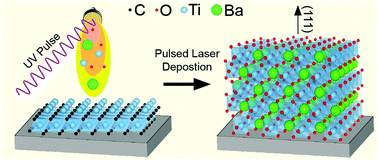van der Waals epitaxy of highly (111)-oriented BaTiO3 on MXene†
Abstract
We report on the high temperature thin film growth of BaTiO3 on Ti3C2Tx MXene flakes using van der Waals epitaxy on a degradable template layer. MXene was deposited on amorphous and crystalline substrates by spray- and dip-coating techniques, while the growth of BaTiO3 at 700 °C was accomplished using pulsed laser deposition in an oxygen rich environment. We demonstrate that the MXene flakes act as a temporary seed layer, which promotes highly oriented BaTiO3 growth along the (111) direction independent of the underlying substrate. The lattice parameters of the BaTiO3 films are close to the bulk value suggesting that the BaTiO3 films remains unstrained, as expected for van der Waals epitaxy. The initial size of the MXene flakes has an impact on the orientation of the BaTiO3 films with larger flake sizes promoting a higher fraction of the polycrystalline film to grow along the (111) direction. The deposited BaTiO3 film adopts the same morphology as the original flakes and piezoresponse force microscopy shows a robust ferroelectric behavior for individual grains. Transmission electron microscopy results indicate that the Ti3C2Tx MXene fully decomposes during the BaTiO3 deposition and the surplus Ti atoms are readily incorporated into the BaTiO3 film. Electrical measurements show a similar dielectric constant as a BaTiO3 film grown without the MXene seed layer. The demonstrated process has the potential to overcome the longstanding issue of integrating highly oriented complex oxide thin films directly on any desired substrate.



 Please wait while we load your content...
Please wait while we load your content...